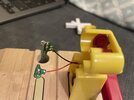Hi all. I need help with how to fix a snapped pcb on my son's toy. It's a level crossing as part of a wooden train set - train travels over it and sets off blinking leds. The part of the board where two leds are has snapped between them.
My original thought was to solder a wire from - to- and another from + to + and glue the board back together. If so, what gauge wire? The existing wire measures ~0.7mm diameter.
Obviously any advice welcome, I really am a novice.
I've attached a photo of the broken section.
Thanks in advance!
Ben
My original thought was to solder a wire from - to- and another from + to + and glue the board back together. If so, what gauge wire? The existing wire measures ~0.7mm diameter.
Obviously any advice welcome, I really am a novice.
I've attached a photo of the broken section.
Thanks in advance!
Ben

